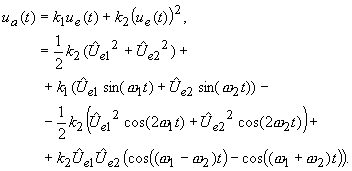compendium |
|
| additive mixture If 2 or more unequal frequencies are beeing amplified these frequencies are getting mixed. This means that there will be sums and differences of the input-frequencies (differential sound) This procedure is called intermodulation. In turn you can mix 2 frequencies in non-linear amplifiers with a square transfer characteristic curve. Since the signals are beeing mixed on the characteristic curve the procedure is called additive mixture: |
|
 |
(61) |
 |
(62) |
| In the case of a square transfer characteristic curve and with the synchronous amplification of two sinusoidal voltages with the frequencies ω1 und ω2 you will find in the spectrum of the output voltage: ua(t) (equation (62)):the constant element and the frequencies ω1, ω2, 2ω1, 2ω2, ω1 - ω2, ω1 + ω2. Check out the experiments on nonlinear distortion to see how the amplitude-modulation of the carrier-frequency is beeing carried out by bandpass-filtering of the input voltage (ω1as the carrier frequency and ω1 - ω2, ω1 + ω2 as the side frequency stay in the frequency range). |